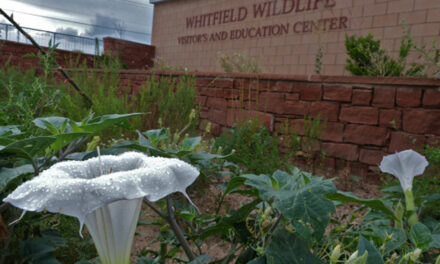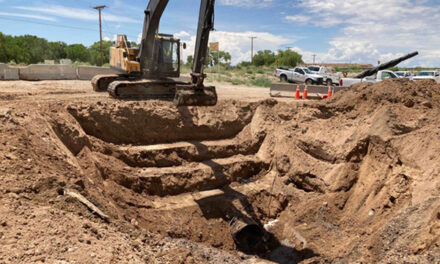(Editor’s note: This article has been updated to correct the number of gallons released in a wastewater spill that requires it be reported to the U.S. Environmental Protection Agency. That threshold is 25 gallons.)
BOSQUE FARMS — Clean-up efforts and testing continue at the Bosque Farms wastewater treatment plant after an estimated 30,000 gallons of wastewater was spilled due to a lift station failure at the plant in late January.
Bosque Farms Village Clerk/Administrator Vernon Abeita updated the council and members of the public at the Feb. 15 council meeting. While meetings are usually sparsely attended, the 52-person capacity room was filled to overflowing that evening.
Abeita laid out the incident in a day-by-day timeline, starting with the actions taken the first day, Monday, Jan. 29.
“The spill was on the grounds of the plant and spilled into the (neighboring village) maintenance yard as well,” Abeita said. “I was advised by (wastewater treatment plant director) David Chavez the spill was being cleaned with chlorine bleach.”
On the second day of the spill — Tuesday, Jan. 30 — Chavez was placed on administrative leave, “but not due to this incident,” Abeita said. “Prior to the spill … people complained about the smell.”
Brent Sellers, with the New Mexico Rural Water Association, visited the plant on the second day of the spill, and had several questions, such as who the compliance officer was for the plant, what was allowed under the discharge permit, and did the village notify the New Mexico Environmental Department and the U.S. Environmental Protection Agency about the spill.
“I could not answer those questions, so I had to defer to the operators at the plant. They couldn’t answer either,” Abeita said. “We were in a bad spot.”
Sellers estimated the spill at 30,000 gallons and told village staff anything more than 25 gallons needed to be reported to the EPA. Abeita said he was told the spill has been reported to the EPA and NMED. Under advice of Sellers, crews began pumping the standing water off the ground that day.

Julia M. Dendinger | News-Bulletin photo
Bosque Farms Clerk/Administrator Vernon Abeita gives an update on the Jan. 29 wastewater spill at the village’s treatment plant to a standing-room-only crowd during the Feb. 15 village council meeting.
On Jan. 31, Abeita reached out to the Pueblo of Isleta for help and began working on a contract for services from them.
“Knowing how they operate and their staff is why I reached out to them. Once upon a time, I was the governor (of Isleta) so I know they have the resources and ability to do it,” he said.
When crews from Isleta arrived, one member, who was a level 4 certified wastewater specialist, took a deep breath and declared “this doesn’t smell right.” The specialist told Abeita the plant “should have an earthy smell. This was not that smell. At this point, it came to light that NMED and EPA were not notified.”
Reports to the two agencies were started, Abeita said, and in the following days, Pueblo of Isleta wastewater workers began spreading chlorine pellets and began inspecting the clarifier, which was not operating at optimal performance.
By day five, Friday, Feb. 2, large red dump trucks from Isleta were removing loads of sludge and dirt from the plant grounds. Abeita said the sludge blanket sitting at the bottom of the clarifier and is integral to the system working correctly was imbalanced, resulting in the smell residents had been reporting.
After the weekend, higher ups with EPA Region 6 had reached out to the village about the spill, asking questions about the clarifier that Abeita said neither he nor the operators could answer.
“It was kind of the blind leading the blind,” he said. “We were looking at drawings and figured out what was and wasn’t working. We are still doing assessments and sending reports to NMED and the EPA.”
On the day of the council meeting, Abeita reported the effluent coming out of the plant was clearer than it has been in the recent past and the facility smells “earthy,” like it should.
“The spill did not get into the clear ditch or the river,” he said. “When the EPA inspected, they found no evidence of it going into either. The plant continued to run and work as best it could. It never went down; it was treating water as best it could. Testing will continue. Results are a little elevated. We have to give it time. We were told it could be up to 90 days to get back to normal operations.”
During the spill, it came to light the village needs a higher certified operator as plant director. Due to the type of system the village operates and the population served, Abeita said they need someone certified at a level 4 for wastewater, which is stipulated in the village’s discharge permit, which was renewed at the beginning of this year.
The village ordinances calls for a level 3 operator to serve as the plan director. At the time he was put on leave, director Chavez held a level 2 certification.
Abeita said level 4 operators are “few and far between … what we’ll probably have to do is contract out those services until we can train someone from within or hire someone. To train a wastewater 4 takes about 10 years.”
Councilor Erica DeSmet said what wasn’t mentioned in Abeita’s presentation was two of the village’s own wastewater operators have been working overtime on the spill. Several times during his presentation, Abeita thanked the operators from Isleta for their help.
DeSmet thanked the workers from the village “for stepping forward when you were not asked and for being everyone’s punching bag for the last few weeks.”
She asked Abeita whether he would be the direct supervisor of the person who would fill the plant director’s position “at the 3 or 4, however that plays out. You kept stating, ‘I didn’t know, I didn’t know.’ How long have you been their direct supervisor?”
Abeita responded since June.
“Were you taking them at their word?” DeSmet asked.
“I took the word of the director since he was the professional,” the clerk/administrator said.
The councilor asked if Abeita made an effort to learn more about operations of the wastewater treatment plant.
“Absolutely,” Abeita said, “but I was met with resistance.”
Mayor Wayne Ake said the important thing to remember was “everybody worked together. It was handled and contained.”
An email from Chavez, written on Feb. 16, and was sent to the mayor, councilors, current and former village employees, was forwarded to the News-Bulletin.
In the email, Chavez says he did contact the EPA to notify the agency about the spill and the actions he would be taking. He says he also met with Mayor Pro Tem Ronita Wood, Councilor Tim Boughman and Abeita the day after the spill.
“While talking with them, I explained why the lift station failed and there was no response,” he wrote. “I also explained the plan for treatment.”
In the email, Chavez contends Abeita didn’t learn about the plant because “… he had no interest and made zero attempts,” and hadn’t visited the plant until the day after the spill. He continued, saying he had issues with Abeita ignoring requests for repairs to the plant and equipment.
Chavez writes in his email he was suspended due to his certification, noting he is a level 2 water and wastewater operator.
Julia M. Dendinger began working at the VCNB in 2006. She covers Valencia County government, Belen Consolidated Schools and the village of Bosque Farms. She is a member of the Society of Professional Journalists Rio Grande chapter’s board of directors.




















